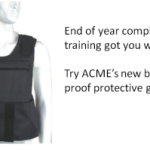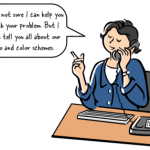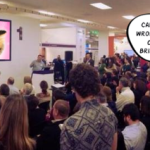[…] This post was mentioned on Twitter by Brian Batt and others. Brian Batt said: RT @tomkuhlmann: Want to Build Better E-Learning Courses? Think Beer http://bit.ly/cekvDT […]
Want to Build Better E-Learning Courses? Think Beer
July 13th, 2010
Did you know that Portland, Oregon has more than 30 breweries? That is the most breweries per capita in the US. Being from the Pacific Northwest, I’m kind of partial to craft beers. I might not like every beer that I taste, but I do enjoy the diversity in flavor.
The thing with beer is that there’s not a right or wrong beer. It would be foolish to argue that a stout is better than a pilsner. They’re different beers for different tastes and occasions. The same can be said for elearning. In fact, I like to use beer as a way to look at elearning courses. Let me explain.
The Many Levels of E-Learning
Often elearning courses are presented in a hierarchy. You may see them described as levels, where level one is information only and level five may be highly interactive. Or you’ll see elearning qualified by the tool used. For example, if the course is created in PowerPoint, then by default it’s low.

While there’s nothing wrong with creating a model like this to describe the different types of elearning, there are a few things I don’t like about it. First, because we assign a number to the levels it implies value without regard to purpose. We tend to view low level as less effective. Or as often is the case, we’ll deride an information-based course as a mere “page turner.”
In fact, at a recent conference an elearning vendor came by the Articulate booth looking to pawn off what she labeled level one courses. She told me that she couldn’t find anyone on her staff that was willing to do “those types of courses.” Apparently, times are good for them.
On the surface a highly interactive, branched scenario might appear to be a better elearning than a very simple linear course. But that may not be the case. It all depends on the purpose of the course.

Something else I see in these models is that PowerPoint authored courses are typically placed at a low level. They’re usually identified as information-only courses. However, by now we all know that’s not necessarily true. PowerPoint’s just a software application and content neutral. You can create either simple, information-only courses or much more sophisticated learning interactions. It just depends on your needs.
Build a Course to Meet Your Objectives
The ultimate goal for elearning is to build a course that meets your client’s needs and learning objectives and that can mean any type of course. Let’s place a flight simulator course at level five and a simple annual compliance review at level one. If I wanted to train pilots to fly the new Boeing 787, I sure wouldn’t want them going through a simple, information-only series of screens. With the people’s lives at stake, they need to be trained in the most sophisticated manner possible. In the same sense, building a complex simulation for a simple compliance course is also the wrong approach.
There’s a place for all types of courses and sometimes what we think of low level is actually the best course. That’s why it’s important to not to get too dogmatic about how a course is built and whether or not it’s interactive. That’s why I like to think of them less in terms of levels and more like beer.

On a hot day, after mowing the lawn, a cold pilsner is more satisfying than a heavier stout. But when I go out to have a beer, I typically prefer the richer flavors of a porter over something lighter. There’s no right or wrong beer where one is of higher value than the other. Beers are just different. So here’s my beer-based elearning meter:
- Is the objective to share information or change performance?
- What level of interactivity do you need in your course?
- What should the course look like?

You’re either viewing or doing. There are plenty of compliance and annual review type courses that are mostly informational. While we could argue that all all courses need to be performance-based, that’s not going to happen. Besides, the course is just one part of the learning process and sometimes all you need is information.
It’s kind of like a text book. Some you just read and reflect. But some are workbooks that provide exercises for you to practice what you’re learning. They all have their place in the learning process; just like elearning courses.

Not all courses require interactivity. While it may be shocking to hear, some people like a bullet point list and don’t want to go through an interactive scenario. On the other hand, one of the valuable elements of elearning is being able to create interactivity that is cost-effective and can be tailored to the learner’s needs.
Don’t bore your learners with bullet point screens, when they’d be better off working through a problem-solving scenario. In the same sense, don’t offer a complex scenario, when all they need is a few key points. Create the interactivity that is appropriate to your objectives.

We don’t want to underestimate the power of good visual design. Graphic design and visual communication are important parts of the learning process. That includes everything from the graphics, the user interface, and how the graphics contribute to the learning objectives.
With that said, there’s no reason to overbuild the graphics either. A first rule is to keep it simple and guide the learner’s attention. You’re better off with a simple line of text on a white screen if it helps the learner focus and understand what you’re trying to teach.
On the other hand, the visual design of your course plays an important role in what you’re communicating. People are drawn to good graphic design. Plus, good design implies value that tells the learner this is worth exploring. It can contribute to an immersive experience that draws
the learner in.
I like the beer model because it’s flexible and acknowledges that elearning courses have differences and some are richer than others. However, it also recognizes that the value of the course isn’t based on where it sits in the model but more on the objectives of the course. And that’s the key, you’re building an elearning course to meet specific objectives and you need to build the right course to do so.
Events
- Everyday. Check out the weekly training webinars to learn more about Rise, Storyline, and instructional design.
Free E-Learning Resources
 |
 |
 |
|
Want to learn more? Check out these articles and free resources in the community. |
Here’s a great job board for e-learning, instructional design, and training jobs |
Participate in the weekly e-learning challenges to sharpen your skills |
 |
 |
 |
|
Get your free PowerPoint templates and free graphics & stock images. |
Lots of cool e-learning examples to check out and find inspiration. |
Getting Started? This e-learning 101 series and the free e-books will help. |
45 responses to “Want to Build Better E-Learning Courses? Think Beer”
That’s it! I’ve been looking at this all wrong…think beer! Although the midsouth doesn’t have the diverse array of craft beers as the Pac NW, it’s rare I drink anything domestic. You’re exactly right – a light lager on a hot summer day is great, just as a Dos Equis Dark is with a burrito, or a Peroni with a Pizza 🙂
Thanks for the enlightenment Tom!
Hi, Tom,
Based upon the statement “It’s kind of like a text book. Some you just read and reflect.” the question that occurred to me is this:
For this type of information delivery, why not just create a text document or a rich text document using, say, Microsoft word?
As always, thank you for sharing your perspective and experience.
Great article Tom. We share the same taste in beer so you should visit Austin, TX and sample our local craft beer.
I’ve found my biggest obstacle is Customers who have everything compartmentalized before you even begin. They have some magic number of frames, and the first struggle is to disconnect them from all their backward ideas that are counter to anything creative or interesting. They want Bud Lite (ugh) and the thought of something else is really “outside the box” for them.
Tom,
Having once been somewhat of a beer connoisseur myself, I totally get your message. One size does not fit all and it is easy to lose sight of course objective in an attempt to make the course entertaining. It’s like when I was a kid going to a good ole’ Southern Baptist Church, it was entertaining; but did anyone get the message?
Hey Tom,
I just read your Blog post from my inbox and was moved to leave a little love in your direction. I am working with a couple of gentlemen that don’t quite understand the eLearning style of teaching. I have forwarded this to both of their inboxes. It explains more that I can convey. It’s a great way to break it down. We will now have a standing barometer and way to communicate how we each feel our courses are being designed.
Lager—Ale—Porter………NICE!
Well done!
-Dave
Hi Tom, Great tips. Your ideas reach well beyond elearning. The beer metaphor applies to web design, document design and so much more. Thanks so much for sharing this.
Hi Tom;
Another great post! I’m introducing e-learning to the organization I’m employed with and am finding that generally, most have been exposed to e-learning via external agencies/organizations and quite often, the content is presented by the means of “page turning”. Currently I am considering an internal “creative think-tank” contest – simply, I’ll give the SMEs a topic and have them derive interesting concepts/ways that the info can be communicated. For reference, I’m having them refer to Articulate’s Community Showcase for ideas, demos, inspiration, etc……My desired result is a quality training piece that has buy-in and promotion from the team that will address our mutual desired outcomes.
Love the analogy Tom… this is my new favorite post and I think it’s one I will share with my client groups
mmm beer
Tom,
Great post as ever.Beers good but how about
Cava -> Brut -> Champagne
How about a post on setting up a business supplying elearning courses?
Keep up the brilliant work!
Loved the analogy. I had been feeling a bit down about the e-guide we had developed after reading the last few posts because we had chosen to go a more informative, rather than interactive, route. After reading this post, I realized that our target user was usually in a state of mental disarray and unable to actively interact with material and so the “lager” format was much more appropriate for them. Users have found the e-guide soothing and useful, so it must have been a good choice. For anyone interested in seeing a sample of what we did, I’ve posted it here.
Hi Tom,
Are you sure you are not Australian with this reference to beer?
Speaking of which, is there any chance you will be heading to Australia at any stage? I am sure I am not the only one here interested in attending some of your presentations.
Like everyone else; thank you for the blogs. They have provided me with great inspiration to produce an excellent learning experience. Thank you, and hoping you will visit Australia soon.
Hi Tom,
Great post as always. I think the advice you offer is essential to raising the standards and therefore perceptions of e-learning as an engaging and effective form of learning, no matter what budget/time/tool/performance issue you are working with.
Tom – I’ve been designing learning technology solutions since 1991 and have tried to encapsulate some key parameters into a memorable model. I’ve blogged on this here:
And I gave a webinar to the Learning and Skills Group in the UK on the subject together with live examples:
http://www.brightwave.co.uk/webinars/designing-e-learning-for-impact-recording
The IMPACT model is a useful framework to review how you can design more effective e-learning. I think anyone of any level of experience, resources and budget can benefit from applying this model to their design activities. We all have a part to play in demanding good design.
Tom, I’d value your and your readers comments and suggestions on how this can be evolved further.
Thanks and again, excellent blog,
Lars Hyland
Hi Tom, great metaphor – I do like it. And with regard to the different flavours of beer – in Belgium we’ve got something like 365 different kinds of beer (one for every day of the year), so there’s always some names that you can use in this kind of explanation.
And for those who are just thirsty, we’ll recommend lighter beers like Stella/Cristal/Jupiler and the like – no taste but it’s liquid.
Keep up the good work.
[…] Want to Build Better E-Learning Courses? Think Beer » The Rapid eLearning Blog the value of the course isn’t based on where it sits in the model but more on the objectives of the course. And that’s the key, you’re building an elearning course to meet specific objectives and you need to build the right course to do so. (tags: elearning) […]
@Danny & Tom – great! I’m in Australia too and was going to say the same thing…Working in the mining industry, there’s a lot of application for elearning, but not a lot of buy-in for guys who operate machines as big as a house to sit in front of a computer. This post could come in handy…
thanks!
[…] by Tom Werner on July 14, 2010 Tom Kuhlmann observes that a hierarchy of “levels” isn’t a good way to think about beer. […]
Hi Tom,
Thank you for “giving us permission” to create some courses that are more of the page turner type. From my experience, the majority of the books and articles as well as my managers make it seem that all good elearning must be highly interactive. They seem to be more concerned with the bells & whistles and less with the content of the courses. Thank you–thank you.
Many years ago during an internal ID training, the trainer told us that the full form ID is not just instructional design but ‘It Depends’. That is what came to my mind reading this post. The elearning solution depends on the problem that you are trying to solve. Actually most of the level-classifications of elearning that I have seen do define the different levels of objective (viewing/doing), interactivity and visual design, but perhaps not as simply and visually as you describe here :-).
Great article and good approach to developing online courses.
However…
The graph “lager – ale – porter” is wrong as “porters are ales”!
A better approach is to look at the style guidelines from the Brewers Association (http://www.beertown.org/education/pdf/BA_Beer_Style_2009.pdf) and Beer Judge Certification Program (http://www.bjcp.org/docs/2008_Guidelines.pdf) of “Ales”, “Lagers” and “Hybrid/Mixed Styles”, where the “Hybrid/Mixed Styles” have characteristics of both lagers and ales. For example, the popular West Coast US Steam Beers are fermented with lager yeasts at the cooler ale temperatures (@60F/15C).
A better graph would be:
“lager – hybrid – ale” or “lager – steam/kolsch – ale”
[…] […]
[…] by Ellen on July 17, 2010 Kudos to Tom Kuhlmann at the Rapid E-Learning Blog for posting “Want to Build Better E-Learning Courses? Think Beer.” Not so much for the beer analogy but for defending (as I have here, in at least one past post) the […]
A simple, yet powerful analogy. It’s quite easy to get caught up in the rating system you describe. I think I’ll have a cold one . . .
Tom – here’s another thought reflecting on previous posts. Customers many times dictate what they want and don’t let those they’ve hired to utilize best practices. For example, they’ll dictate the technology, which can overshadow the objectives and learning outcome. It speaks to your point of using the right approach for the need and not overdoing it. . .
I liked the model showing level 1-5. I think that is it the bit between 1-5 that people have the most problem with. The visual design element is very much like the concept that Garr Reynolds discusses in his book Presentation Zen.
Great analogy here, I try to keep my e-learning to interactive yet informational and not focus on the program used, but the content itself. Can’t tell you how many seminars I have sat in and been completely bored out of my mind.
[…] Want to Build Better E-Learning Courses? Think Beer […]
Tom,
You may want to do a bit of fact checking, and then come for a visit! Asheville, NC, my hometown, tied Portland for the “Beer City USA” moniker this year, and we officially have more breweries per capita than Portland (you data was dated 2008).
http://www2.journalnow.com/content/2009/dec/19/breweries-asheville-has-the-most-in-the-us/
It’s a great place for beer (and the e-learning is not bad either). Great tips! Keep them coming!
What in inspirational post I definitely need more beer in my e-learning
[…] ASTD chapter. David and I met some nice people and got to do some research to support a recent blog post. we also discovered that Indianapolis has two airport terminals. One is new and looks […]
Tom, your conference trips seem to be always in the US. Come on over to the UK – would be great to meet you and participate in a live session! thanks for all the great tips.
Great tips. Your ideas reach well beyond elearning. The beer metaphor applies to web design, document design and so much more. Thanks so much for sharing this.
the E-learning course is very dynamic boyth practical and theory, mr Tom how can Ilearn this dramatically approach project course specially the e-learning course buildin blog and its not yeb interactive towards me
Great analogy but Saying a Lager is light and Porter dark is like saying a Ferrari can only be Red and a Truck can only be silver.
There are two types of beers. Lagers and Ales. They come is all forms of colors and flavors. They’re differenciated by the fermentation processe. A Schwarzbier is a lager and it is black like a porter. It woule be better to change the Lager into Pilsener and Ale into Amber or something staying with the them of beer styles. BTW… a Porter is also an Ale. As is a Hefeweizen (very light).
Tom,
This is a great post. I absolutely loved the beer analogy.
I’ve been involved with custom e-learning development for about 10 years now and nothing bugs me more than the ‘levels of e-learning’. I completely agree when you say “because we assign a number to the levels it implies value without regard to purpose. We tend to view low level as less effective. Or as often is the case, we’ll deride an information-based course as a mere “page turner.””
Come to think of it – are there any awards for “most appropriate e-learning”. Not that every e-learning solution is created for winning awards but probably that’s what the designers get excited about when when working on e-learning project. They all would want to do only ‘higher level’ courses. You did meet an e-learning vendor saying that. 🙂
I wrote a blog post some months back on the levels of e-learning & costs, if you wish – A Fresh Look At Levels of Custom eLearning Solutions
Thanks
[…] Want to Build Better E-Learning Courses? Think Beer. […]
[…] Build Better E-Learning They’re different beers for different tastes and occasions. The same can be said for elearning. In fact, I like to use beer as a way to look at elearning courses. QualityManagement Planung + Organisation Organisierung & Tools eLearning Tools Collaboration Platforms/Tools [+] Marketing brainstorming support Online Data Sources (Fontes de Dados) spending Historia teachers Instrumental online knowledge_management advancing sketching Timelines planetquest google dipity Líneas-Tiempo preceden timetoast Institutions agentur united ready Gantt-Diagramme howto Know-how & ssues sevenone sentürk Projectmanagement oldstatic gesellschaft UML application modeling development projekmanagement projektmanagement http://www.sophie-laurent-lacreche.audomicile.com travail xtimeline create explore Outils de Mindmapping graphic knowledge Nature, Simple Life & Ecology gemeinwohl anthropology people agenda rebel maps cooltoolsforschools online RSS_feeds simple official heard Terminmanagement netzplantechnik elearning tools comparing creaza powerpoint Project Management result meeting finally Study Material Creation creating repulsion eLearning Courses Management learning development complete Présentations & Conversions Animation et Sons known Programming Methodologies & Paradigms development javascript ECDL komplettanbieter forschungsdokumentation Travel passport Images featured photo video animation vimeo radio Data about Latin America (Dados sobre América Latina) general Data about Brazil (Dados sobre Brasil) acabar politics Research Methodology (Métodos de Pesquisa) methods data sources for sociology (fontes de dados para sociologia) bureau openlayers Graphic Design simple Graphic Design script piknik download beautiful remarkable Software source Action Management anhand ermittelt Design Work home • contact • blog • fb • twitter to experience pearltrees activate javascript. […]
[…] On the other hand, the visual design of your course plays an important role in what you’re communicating. People are drawn to good graphic design. Plus, good design implies value that tells the learner this is worth exploring. It can contribute to an immersive experience that draws the learner in. I like the beer model because it’s flexible and acknowledges that elearning courses have differences and some are richer than others. However, it also recognizes that the value of the course isn’t based on where it sits in the model but more on the objectives of the course. Want to Build Better E-Learning Courses? Think Beer » The Rapid eLearning Blog […]
[…] Want to Build Better eLearning Courses? Think Beer […]









0
comments